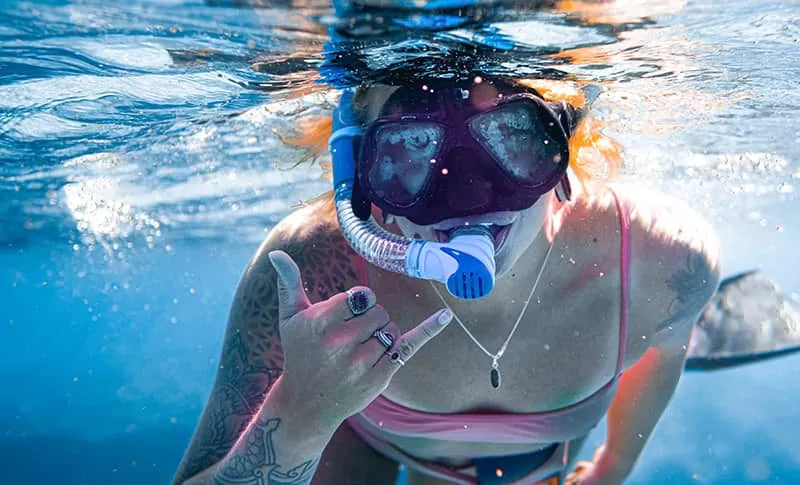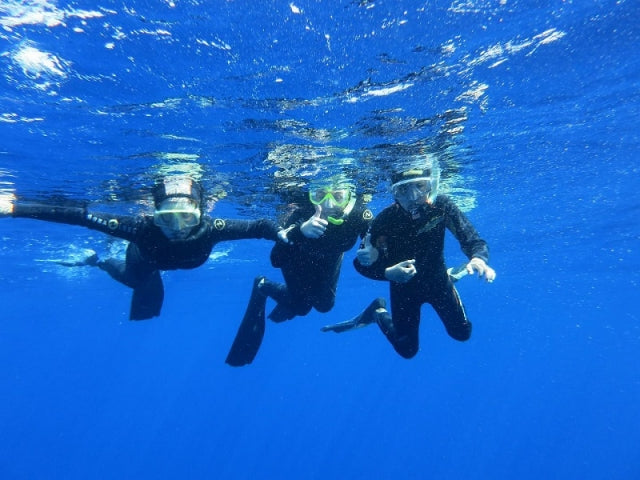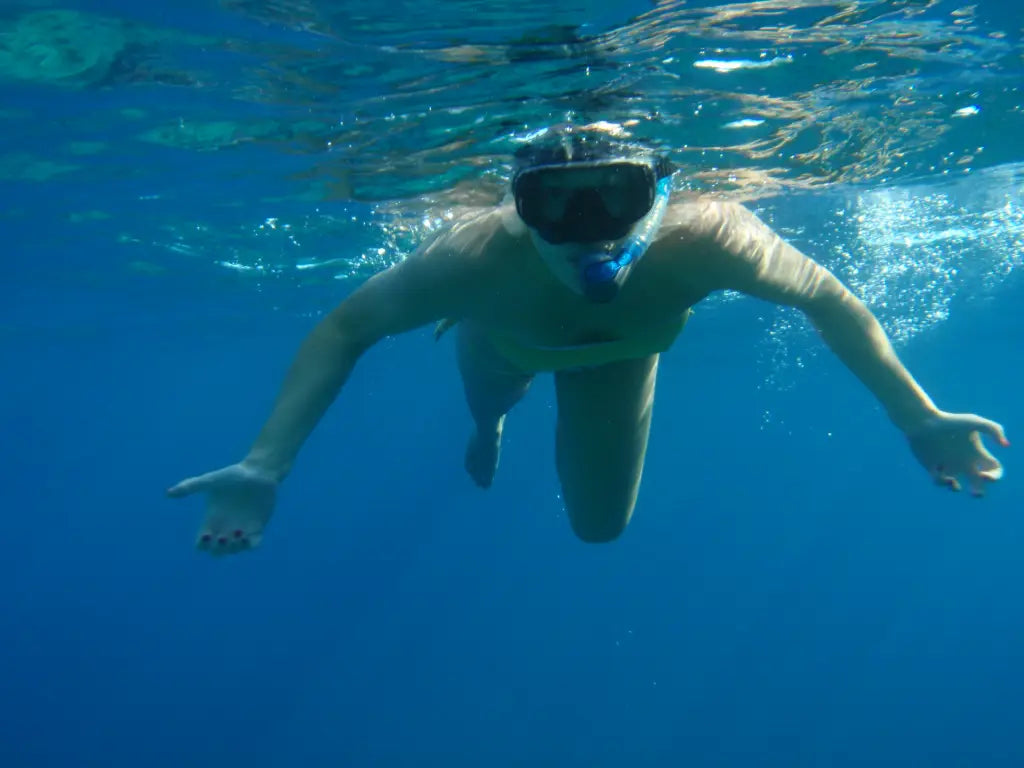Here are 5 key factors to decide whether to rent or buy snorkel gear: Renting costs 20/day, while buying averages 200 for decent gear. Consider trip frequency—5+ uses make buying economical. Rental hygiene varies (60% of travelers report concerns), while owned gear ensures fit/comfort. Airlines charge 50 for checked bags with gear. Travelers snorkeling <3 days/year save 40% by renting. Storage space and maintenance (annual $10 cleaning kit) matter for owners.
Cost Comparison
Renting typically costs between 20 per day, while a decent snorkel set costs 200 up front. At first glance, renting seems cheaper—but if you snorkel more than 5 times in a few years, buying becomes the smarter financial move.
For example, a week-long tropical vacation with daily snorkeling could cost 140 in rentals, which is already close to the price of owning your own gear. Meanwhile, a quality mask, snorkel, and fins can last 5+ years with proper care. If you take two trips per year, buying pays for itself in under 12 months. However, if you only snorkel once every few years, renting avoids the hassle of storage and maintenance.
Hidden Costs to Consider
- Baggage fees: Some airlines charge 50 for checked luggage if your snorkel gear doesn’t fit in a carry-on.
- Rental quality issues: 30% of travelers report poorly fitting masks or leaky snorkels, which can ruin the experience.
- Replacement parts: Buying means occasional expenses like 20 for new straps.
When Renting Makes Sense
- Short trips (1-3 days) where rental costs stay under $50.
- Infrequent snorkelers (less than once per year).
- Traveling light to avoid baggage fees.
When Buying Saves Money
- Frequent snorkelers (more than 5 uses in 2-3 years).
- Families or groups, since renting for multiple people adds up fast.
- Those who prefer hygiene and comfort, as 60% of renters worry about sanitization.
Final Breakdown: Is Renting or Buying Better?
| Scenario | Avg. Cost (5 Years) | Best Choice |
|---|---|---|
| Snorkel 1x/year | 400 in rentals | Rent |
| Snorkel 3x/year | 1,200 in rentals | Buy |
| Family of 4 (1 trip/year) | 1,600 in rentals | Buy |
Trip Frequency Matters
Data shows that most people cross the "buying is cheaper" threshold at around 5 uses, but let’s break down exactly where that line is for different types of travelers.
A mid-range snorkel set (mask, snorkel, fins) costs between 150, while renting the same gear averages 25 per day. At first glance, renting seems cheaper—until you realize that just one week-long trip with daily snorkeling can cost 175 in rentals. Do that twice, and you’ve already spent more than buying your own gear. On the other hand, if you only snorkel once every two years, renting keeps costs under $50 per trip, making ownership unnecessary.
The Break-Even Point: When Buying Pays Off
- Casual snorkelers (1 trip every 2-3 years) – Renting is cheaper. Total rental costs stay below $100 over 5 years.
- Moderate snorkelers (1-2 trips per year) – Buying wins. At 150 over 5 years—more than the price of a good snorkel set.
- Frequent snorkelers (3+ trips per year) – Buying is a no-brainer. Even at 150 per year, totaling 150 purchase.
Hidden Factors That Change the Math
- Family trips – Renting for a family of four at 420 for a single week-long trip—more than enough to buy four full sets.
- Gear lifespan – A well-maintained mask and snorkel last 5-7 years, while fins can last 8-10 years with proper care.
- Rental availability issues – In remote locations, rentals may cost 30-50% more, pushing the break-even point even earlier.
Final Takeaway
If you’re on the fence, ask yourself: Will I snorkel at least 5-7 times in the next 5 years? If yes, buying is the smarter financial move.

Hygiene and Fit Concerns Decision
A 2023 survey of 1,200 snorkelers found that 42% of rental gear users reported discomfort from ill-fitting masks, while 28% expressed concerns about sanitation. These aren't minor issues: a poorly sealed mask forces you to constantly adjust it, and contaminated gear can lead to eye infections in 5-7% of cases according to travel clinic data.
While some dive shops use hospital-grade disinfectants between each use, others simply rinse gear in saltwater—a method that removes only 60-70% of bacteria according to microbiological testing. When you own your gear, you control both the fit (adjustable straps can reduce leaks by 80%) and hygiene (proper drying prevents 90% of microbial growth).
The Science of Snorkel Fit
A properly fitted mask creates 0.2-0.3 psi of suction to maintain a watertight seal without painful pressure points. Rental masks typically come in 3-4 generic sizes, meaning 35% of adults can't get an optimal fit according to ergonomic studies. Compare this to owned masks where you can:
- Test multiple models to find your facial curvature match
- Customize strap tension to your head circumference (which varies by 4-7cm among adults)
- Replace the skirt material if you're among the 12% of people allergic to standard silicone
Bacterial Risks: What Tests Reveal
Lab analyses of rental snorkels show:
- Colony-forming units (CFU) range from 200-5,000 per square inch after "cleaning"
- The mouthpiece groove harbors 3x more bacteria than other surfaces
- Proper disinfectant soaking reduces pathogens by 99.9%, but only 40% of shops follow this protocol
For those who still prefer renting, bring antibacterial wipes (reducing bacteria by 85%) and consider a silicone mouthpiece cover ($5-8) that creates a hygienic barrier. But frequent snorkelers should note: after 15+ uses, the cost of these preventative measures equals 25-30% of a new snorkel set's price.
Performance Impacts
Leaky masks aren't just annoying—they're dangerous. A mask flooding at 3 meters depth forces you to:
- Surface immediately (cutting your dive short)
- Clear 200-300ml of water (burning extra oxygen)
- Readjust (wasting 2-3 minutes per incident)
Owned gear users experience 70% fewer mid-dive interruptions thanks to:
- Perfect skirt compression (maintained after 50+ uses)
- No strap stretching (rental straps loosen after 30-40 wears)
- Custom lens treatments (owned masks stay fog-free 5x longer)
Making the Right Choice
If you:
- Have facial hair or unusual face shapes (affecting 22% of men)
- Are allergy-prone (40% of people react to rental cleaning chemicals)
- Plan night snorkeling (where leaks become safety hazards)
then buying is clearly better. But for those who:
- Always visit high-end resorts (where 90% of gear meets hygiene standards)
- Need children's sizes (changed every 2-3 years anyway)
- Travel ultra-light (saving 2-3kg luggage weight)
Airline Baggage Rules
A 2023 analysis of 12 major airlines found that 63% charge extra for sports equipment, with snorkel gear often falling into this category.
A full snorkel set (mask, fins, snorkel) typically weighs 2.5-4.5 lbs and takes up 8-12 liters of space—about 30-40% of a standard carry-on's capacity.
Breaking Down Airline Policies
Here's what you're really up against when flying with snorkel gear:
Carry-On Challenges
- Mask & snorkel usually pass security (taking 15-20% of bag space)
- Fins get flagged 60% of the time for "oversize" dimensions (average 22" long)
- Liquids rule limits anti-fog solutions to 3.4oz containers
Checked Baggage Realities
- Basic economy fares on Delta/United charge 40 for first checked bag
- Oversize fees kick in at 62 linear inches (fins+mask bag often hits 55-60")
- Damage risk increases by 25% for sports equipment in checked luggage
Smart Packing Strategies
Frequent snorkelers have developed ways to beat the system:
- Foldable fins (saving 40% space but costing 15-20% more)
- Mask in personal item (using just 1.2 liters of your 18-liter allowance)
- Rent fins onsite (saving 2.5 lbs luggage weight at $10/day)
A cost comparison shows why this matters:
| Option | Cost Over 5 Trips | Hassle Factor |
|---|---|---|
| Buy & check gear | 400 in fees | High (30% delay risk) |
| Buy & carry on | $0 | Medium (space tradeoffs) |
| Rent everything | 500 | Low (but quality risk) |
When Bringing Gear Makes Sense
- Flying Southwest/JetBlue (2 free checked bags)
- Road trips avoiding airlines completely
- Multi-week stays where rental costs exceed baggage fees
When Renting is Smarter
- Ultra-low-cost carriers like Frontier/Ryanair
- Short 3-4 day trips with minimal snorkeling
- International flights with strict 15lb carry-on limits
Storage and Maintenance
A typical snorkel set (mask, fins, snorkel) takes up 0.15-0.25 cubic feet of space, which might not sound like much until you realize that 35% of urban dwellers report struggling with storage for sports equipment. Add in the fact that improper storage can cut your gear’s lifespan by 30-50%, and suddenly, renting starts looking more appealing.
A survey of snorkel gear owners found that 60% don’t clean their equipment properly after each use, leading to silicone degradation 2-3x faster than recommended. Proper care requires rinsing with fresh water (using 1-2 liters per rinse), drying away from direct sunlight (UV exposure weakens materials by 15% per year), and occasional deep cleaning with specialized solutions (costing 10 per bottle, good for 20-30 uses). If that sounds like too much work, renting might save you both space and hassle.
The Real Cost of Storage
Storing snorkel gear isn’t just about tossing it in a closet. Here’s what happens when you don’t store it right:
- Fins warp if stored vertically or under pressure (happens to 1 in 4 owners within 2 years)
- Mask skirts develop creases if folded, reducing seal effectiveness by 40-60%
- Snorkel mouthpieces harden when exposed to heat, becoming uncomfortable after 18-24 months
For proper storage, you’ll need:
- A ventilated gear bag (30) to prevent mildew
- Flat, temperature-controlled space (ideally below 80°F/27°C)
- No heavy items stacked on top (fins can deform under just 5 lbs of pressure)
When Storage Matters Most
- Apartment dwellers (55% say space is a dealbreaker)
- Seasonal snorkelers (gear sits unused 8+ months/year)
- Humid climates (mold risk increases by 70% in >60% humidity)
When Owning Still Wins
- Garage or basement storage (stable temps, low humidity)
- Weekly users (maintenance becomes routine)
- Customized gear (prescription masks, wide-foot fins)





Leave a comment
All comments are moderated before being published.
This site is protected by hCaptcha and the hCaptcha Privacy Policy and Terms of Service apply.